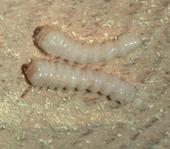House longhorn beetle (Hylotrupes bajulus)
The house longhorn beetle (Hylotrupes bajulus) belongs to the longhorn beetle (Cerambycidae) family and is one of the most significant destroyers of coniferous timbers.
Roof trusses, beams, floorboards, doors, stored wood or timber used outdoors all face a high risk of attack.
What does he look like?
House longhorn beetles are between 8 an 25 mm long, blackish brown in colour and have two greyish white patches of hair on the wing covers. A further characteristic feature is the two shiny bumps on the neck shield. In the final stage, the larvae are 2 – 3 cm long and 4 – 6 mm thick, pale cream in colour and their bodies are made up of ring-shaped segments.
How do they attack the wood?
The actual wood destroyers are not the beetles themselves, but their larvae. The beetle’s life span is only a few weeks between June and August and during this time they do not destroy wood. Their only aim is to reproduce.
After mating, the females lay their eggs in fine cracks in the wood. Once the larvae hatch, they gnaw their way into the wood, where they live for 3 to 6 years (though even 15 years have been observed) and feed mainly on sapwood. At the end of this period, they pupate in the wood and metamorphose into adult house longhorn beetles. They then gnaw a hole in the thin outer surface and immediately search for a mating partner.
What damage can they do?
Depending on the extent of infestation, the large frass galleries made by the larvae can lead to a considerable weakening of wooden structures and components. The problem is exacerbated by the difficulty in recognising house longhorn infestation, because the larvae attack the inside of the timbers and leave a very thin surface layer of wood untouched. As a rule, no bore dust emerges and so, frequently, infestation only becomes visible when the beams or floor boards actually break.
How can infestation be remedied?
House longhorn infestation can cause serious and extensive damage and so must be treated. Affected timbers must be replaced or the infected wood cut away and treated properly with wood preservative. In addition, neighbouring timbers not yet affected should also be treated preventively with wood preservative to prevent infestation spreading to these components.
Alternative measures include heat treatment or fumigation, though neither method offers protection against house longhorn beetles attacking again.




